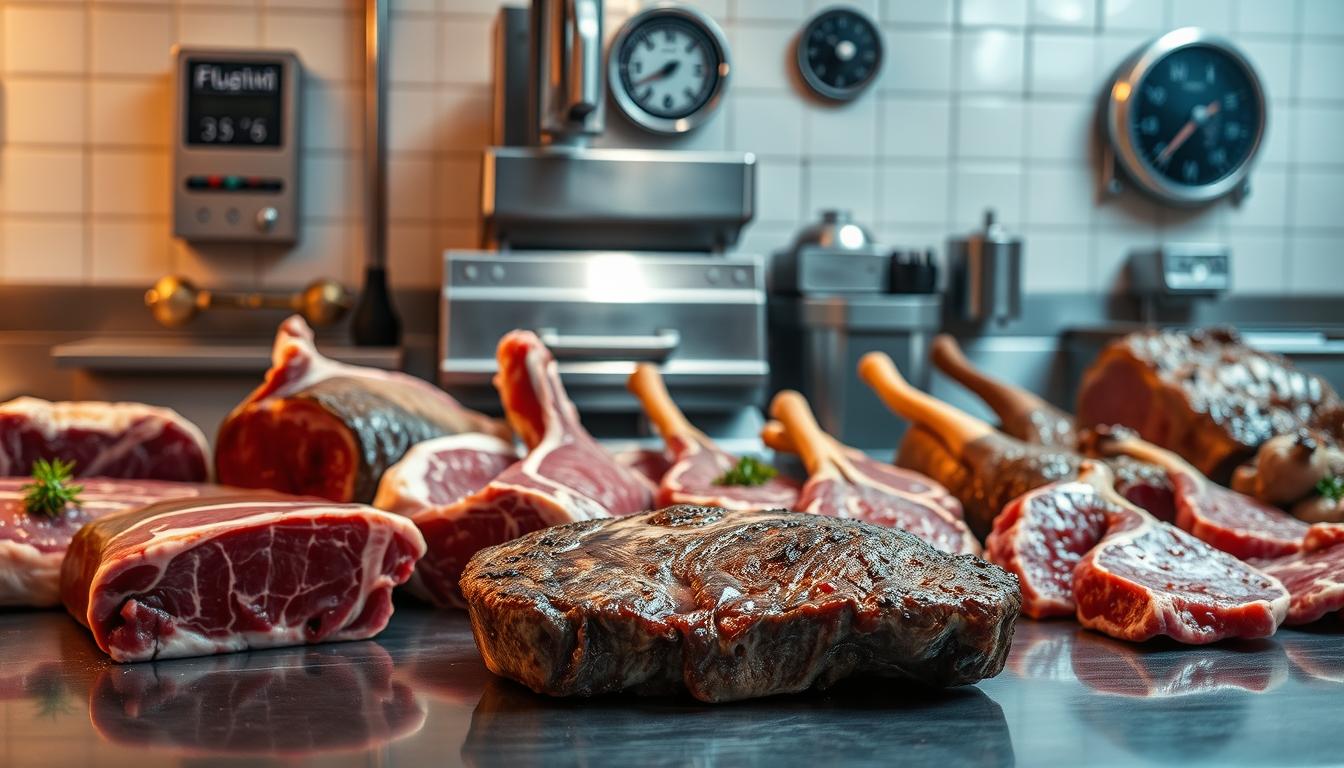Juicy steaks and tender roasts aren’t just luck – they’re physics in action. Every piece of uncooked protein contains microscopic water-filled tubes called myofibrils. These structures act like natural juice reservoirs, keeping flavors locked tight until heat changes everything.
When you apply heat, muscle fibers contract like squeezed sponges. About 40% of moisture gets forced out, creating those sizzling pan drippings. But here’s the twist: cutting immediately traps those juices on your cutting board instead of your plate.
Professional chefs use a simple trick. Letting cooked protein sit allows muscle fibers to relax. Myofibrils gradually reabsorb escaped liquids, boosting flavor and texture. This isn’t folklore – it’s food chemistry working at the cellular level.
Understanding these reactions transforms kitchen results. You’ll create restaurant-quality meals by mastering how temperature and timing affect molecular structures. No fancy tools required – just knowledge of how proteins behave under heat stress.
Key Takeaways
- Muscle fibers contain water-holding structures critical for juiciness
- Heat forces moisture loss through contracting proteins
- Resting reverses shrinkage through molecular relaxation
- Reabsorbed liquids enhance flavor distribution
- Timing determines texture more than cooking duration
Understanding the Importance of Resting Meat
Your perfectly cooked steak’s tenderness depends on a critical step after the oven. Heat triggers molecular shifts that determine whether juices stay trapped or end up on your cutting board. Mastering this phase separates rushed meals from restaurant-quality results.

How Muscle Fibers Respond to Heat
Exposing proteins to high temperatures causes immediate changes. Muscle fibers contract like coiled springs, pushing nearly half their moisture into surrounding spaces. This liquid contains dissolved proteins and fats – the essence of flavor you want to preserve.
Cutting too soon releases these thin, hot juices rapidly. Letting fibers cool slightly reverses their tension. Relaxed tissues reabsorb escaped liquids, preventing dry textures. Timing matters: even 5 minutes makes proteins more receptive to retaining moisture.
The Role of Juices in Tender, Flavorful Meat
Escaped liquids aren’t just water – they carry taste compounds and softening enzymes. Redistributing them evenly requires patience. As meat rests, thicker juices bind to muscle structures instead of pooling externally.
| Factor | Rested Meat | Unrested Meat |
|---|---|---|
| Juice Retention | Up to 72% retained | 40-50% lost |
| Tenderness | Even texture | Chewy spots |
| Flavor Distribution | Balanced in every bite | Concentrated at edges |
Thicker juices also cling better to meat surfaces during slicing. This creates self-basting cuts that stay succulent longer. Proper resting transforms pan drippings from watery to rich, ideal for sauces.
The Science Behind “Resting” Your Meat
Ever wonder why patience pays off with succulent cuts? Cellular structures undergo crucial changes during those quiet minutes off the heat. This phase determines whether moisture stays trapped or escapes as wasted flavor.

Reabsorption of Natural Juices
Heat-stressed muscle fibers gradually unwind during downtime. Relaxed myofibrils act like microscopic sponges, pulling back expelled water molecules. Cooling juices thicken as dissolved gelatin solidifies, creating a sticky texture that clings to muscle tissue.
| Aspect | During Resting | Without Resting |
|---|---|---|
| Juice Viscosity | Thick, gel-like | Watery |
| Moisture Distribution | Evenly spread | Pooled at edges |
| Fiber Tension | Relaxed | Contracted |
Molecular Insights into Meat Resting
Fat droplets within cooling liquids firm up, locking flavors into place. This process peaks between 7-15 minutes for most cuts. Extended waiting periods allow more complete rehydration of muscle strands.
Carving too early ruptures fragile cell walls still under heat stress. Proper timing lets proteins stabilize, creating a moisture-retaining matrix. You’ll notice the difference in every juicy bite.
Optimal Resting Times for Different Meat Cuts
Unlocking juicy results starts with matching rest periods to protein size. Thermal mass dictates timing – thicker cuts hold heat longer, requiring extended pauses for proper juice reabsorption. This principle applies whether you’re searing a ribeye or roasting a holiday turkey.

Timing Guidelines for Thin Cuts
Thinner proteins like chicken breasts and steaks need 5-10 rest minutes. Their compact size allows rapid heat dissipation, but rushing the process wastes flavor. Watch for these signs:
- Surface juices stop bubbling
- Meat feels slightly firmer when pressed
- Internal temperature stabilizes
Extended Resting for Large Proteins
Whole birds and roasts demand 15-30 minutes. Their dense structure retains heat, continuing gentle cooking while redistributing moisture. Use this table to plan perfectly timed meals:
| Cut Type | Thickness | Rest Minutes | Juice Retention |
|---|---|---|---|
| Steak | 1-1.5″ | 5-10 | 68-72% |
| Chicken Breast | 0.75-1″ | 7-9 | 65-70% |
| Pork Roast | 4-6 lbs | 20-25 | 75-80% |
| Whole Turkey | 12-14 lbs | 25-30 | 82-85% |
Adjust times for cooking methods – grilled meats may need extra rest minutes compared to oven-roasted cuts. Always tent loosely with foil to maintain warmth without steaming the surface.
Managing Carryover Cooking After Resting
Timing your cook isn’t just about the flame – it’s about physics at rest. Proteins continue their thermal journey even off the heat, a phenomenon chefs call carryover cooking. This hidden temperature climb separates perfectly cooked cuts from dried-out disappointments.

Avoiding Overcooking through Temperature Management
Steaks gain 5-10°F (3-6°C) during resting, pushing medium-rare to medium if unchecked. Always pull proteins 5°F below your target doneness. Thicker cuts like roasts may rise 15°F (8°C) due to retained heat in their core.
Use this table to plan removal points:
| Cut | Target Doneness | Remove At |
|---|---|---|
| Ribeye (1.5″) | Medium-rare (130°F) | 120-125°F |
| Chicken Breast | 165°F | 155-160°F |
| Pork Tenderloin | 145°F | 135-140°F |
Ambient conditions affect results. A warm kitchen accelerates carryover cooking, while foil tents trap escaping heat. For delicate proteins like fish, reduce resting time to 3-5 minutes to prevent overdoneness.
Invest in a digital thermometer to track internal temperature changes. Let thicker cuts rest on wire racks – this cools surfaces faster while allowing centers to stabilize. Remember: residual heat works slower in bone-in cuts but penetrates deeper over time.
Practical Tips for Resting Your Meat
Post-cooking steps separate rushed meals from memorable dining experiences. Three tools dominate this phase: aluminum foil, sturdy boards, and controlled heat sources. Mastering their use preserves texture while maximizing flavor retention.

Using Foil, Cutting Boards, and Warm Ovens Effectively
Tent your steak loosely with foil – create an air gap to trap heat without steaming crispy crusts. For thick roasts, use oven mitts to transfer them to a grooved board. This catches drips while allowing airflow around the protein.
Warm ovens (170°F max) maintain temperature for large cuts. Place a rack under the pan to prevent bottom sogginess. Pro tip: Wooden boards insulate better than plastic, slowing heat loss during the process.
Best Practices to Maintain Ideal Temperature and Texture
Follow this 3-step sequence for optimal results:
- Transfer meat using tongs, not forks (prevents juice leakage)
- Elevate on a wire rack over the board
- Time rest periods using a smartphone alarm
Countertop resting works best for thin cuts in busy kitchens. Watch for these readiness signs:
- Surface stops hissing
- Juices pool slightly around edges
- Internal temp drops 5°F
| Method | Best For | Max Time |
|---|---|---|
| Foil Tent | Steaks, Chops | 12 mins |
| Warm Oven | Roasts, Whole Birds | 30 mins |
| Countertop | Burgers, Fish | 8 mins |
Coordinate resting with side dish preparation. Slice vegetables or make pan sauces while proteins redistribute juices. This workflow ensures hot, cohesive meals without time gaps.
Science-Backed Results and Experimental Insights
Laboratory-tested evidence proves what chefs swear by. Cooks Illustrated’s controlled study with boneless pork loins reveals dramatic moisture retention differences based on post-cook handling. Their method? Five identical roasts cooked to 140°F, each subjected to varying rest periods before slicing.
Findings from Cooks Illustrated and Other Research
Immediate carving caused 10 tablespoons of liquid loss – enough to drown flavor. But waiting just 10 minutes slashed that number to 4 tablespoons. That’s 60% less moisture escaping through rushed cutting. Extended pauses delivered even better results:
| Rest Period | Juice Loss | Retention Gain |
|---|---|---|
| 0 minutes | 10 tbsp | Baseline |
| 10 minutes | 4 tbsp | +60% |
| 20 minutes | 2.5 tbsp | +75% |
| 40 minutes | 2 tsp | +93% |
Comparative Analysis of Juice Retention Over Time
Thicker proteins benefit most from extended pauses. The pork study shows each additional rest minute helps reabsorb escaping liquids. After 40 minutes, 93% of original moisture remained trapped in muscle fibers.
This data explains why competition pitmasters wrap briskets for hours. Cooler temperatures let gelatin-rich juices solidify, creating that coveted melt-in-your-mouth texture. Your home kitchen can achieve similar results by adjusting wait times to protein size.
Key insight: Even brief pauses dramatically improve outcomes. Ten minutes transforms pork from dry to juicy – no special equipment required. Patience proves more effective than expensive gadgets for moisture retention.
Conclusion
Mastering this final phase transforms good dishes into exceptional ones. Whether working with steaks, chops, or whole roasts, the principle remains unchanged: pause before slicing. This simple step lets muscle fibers reabsorb juices that would otherwise escape, creating moist results every time.
Grilled proteins particularly benefit from brief downtime. Heat from charcoal or gas penetrates deeply, making food science principles critical for preserving texture. Even quick-cooked items like chicken breasts gain 15-20% more retained moisture with proper resting.
Follow these guidelines for success:
- Match rest duration to protein thickness
- Use foil tents for heat retention without steaming
- Track carryover cooking temperatures
Your efforts yield flavorful rewards. Juices redistribute evenly through each piece of meat, enhancing every bite. From backyard barbecues to holiday feasts, applying these techniques ensures professional-quality results in home kitchens.



